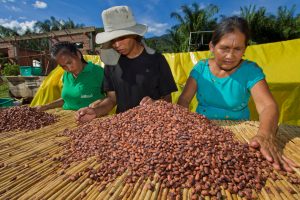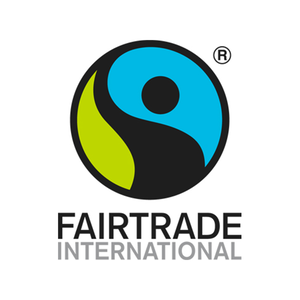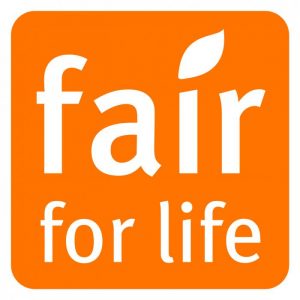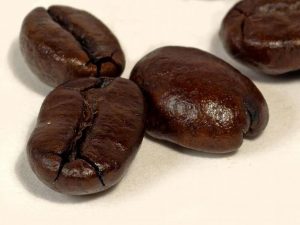I used to be a barista. “Are your beans certified?”, people would ask as they waited on the counter and as I struggled with the latte art. “Yes,” I´d answer, pointing at the many seals attached to our coffee bean bags. There were three, but they differed depending on the batch: Fairtrade Labeling Organization (FLO), Fair Trade USA and Fair for Life. The word FAIR, however, seemed like enough for most clients and, honestly, for me.
Fair trade is a buzzword in most markets and restaurants. On principle, it’s pretty hard to disagree with fairness. Like “sustainability” among environmentalists, or “critical thought” among educators, “fair trade” seems like a marketing prerequisite, even if many consumers don’t necessarily understand exactly what it’s about.
So what is fair trade? How is a Fair Trade USA certificate different from a Fair for Life certificate? What is the difference between a product that is considered to be fair trade and one that is Fair Trade (or Fairtrade) certified?
What’s the deal with me using capital letters in some cases (“Fair Trade”) and not in others (“fair trade movement”)? These questions matter and have been the subject of often heated debate. We know not everyone has time to go on long internet quests for complex answers, so we’ve gathered a brief crib sheet with 5 key things you need to know about fair trade certifications.

1. One philosophy.
Fair trade in the broadest sense is a social movement with roots in the 1960s and with the objective of creating an alternative market for small farmers in developing countries. The philosophy behind it is quite simple: to practice commerce consciously and ethically, in a way that truly benefits buyers and producers alike. In other words: use your purchasing power to create better lives for farmers, not to exploit them. By creating an alternative market, the fair trade movement allows consumers to actively choose products offered by small farmers from specific regions. Generally, fair trade aims to pay exporters more for the added value of meeting higher production and labor standards and to fund a premium to support social projects of producer groups.
The movement also aims to establish closer links between producers and buyers. Because that´s difficult when you buy from far away, fair trade promotes longer term contracts between farmers and distributors in order to build trust and establish more stable commercial relationships.
According to the World Fair Trade Organization, the philosophy behind the movement consists of 10 principles which producers organizations must uphold.
2. From movement to labels.
In the 1980s the movement incorporated labeling to let consumers know what they were getting and as a way to drive more demand to better agricultural practices. This, however, is where things can get more confusing: there are several labeling models, each with their own certification standards. While some labels share many of the same principles, in order to get certified farmers must strictly comply with production standards that are particular to each certification.
The three labels I remember from the coffee shop are also the three most recognized labels around the world. The Fairtrade Labeling Organization (FLO) (which by 2014 had 1226 certified producer organizations across the world), Fair Trade USA (with nearly 12,000 certified products and more than 500 certified producer organization) and Fair for Life (with over 3000 FFL certified products), in principle are all committed to promoting dialogue, transparency, and respect in commerce. But while their differences are subtle, they are worth noting in order to make more informed consumer choices. They each adhere to their own technical criteria:
Fairtrade Labeling Organization International (FLO): FLO was established in Germany in 1997 to set global certification standards. Their stated mission is to connect disadvantaged producers in order to promote better working conditions and to fight against poverty. Though with exceptions like bananas, FLO prioritizes work with small farming cooperatives.

If a product carries this label, it means that farmers (often through cooperatives) have been paid a fair price for it, that they’ve received a Fairtrade Premium amount above the fair cost to invest in their communities, and that they have met rigorous production standards. This label also guarantees that the entire supply chain has been monitored according to specific social and environmental standards for the work at each stage: small producer organizations, hired labour, traders. Products that carry this label are audited by FLO’s audit and certification body, FLOCERT.
Fair Trade USA: Fair Trade USA (formerly TransFair USA) and Fairtrade International (FLO) share many of the same principles, because they were once part of the same organization. There is one main difference: in an effort to expand their reach, Fair Trade USA split from the global organization (FLO) in 2011 to allow participation by large plantations and estates as long as their workers were treated fairly (in compliance with their own labor and well-being standards). Meanwhile FLO has maintained a near-exclusive focus on producer-owned coops. Each organization and supporters have argued that their models are the best way to transform markets.

The story behind these differences becomes more complex and interesting the more you learn about them. And to many, this controversy is political in essence.
Fair for Life: Many things had labels at our coffee shop. I particularly remember that the soap was labeled “Fair for Life”. That´s because the standard of Fair for Life is much broader, not product-specific. That means that, unlike both FLO and Fair Trade USA, Fair for Life certifies finished, manufactured products (cosmetics, textiles and crafts) as well as agricultural produce (chocolate, mangoes, almonds). Hence, Fair for Life not only certifies farmers, but also producers, traders, and manufacturers (factory workers). Another important difference to remember is that Fair for Life, with its own specialized For Life standard, is the only label that also certifies entire companies.
While Fair for Life is able to certify manufactured products by being more flexible, it focuses on what they describe as the “essentials”: the control of good working practices along the supply-chain, accountability, better relationships between suppliers and buyer and close communication and transparency.
Fair for Life is an option for operators who have been excluded by other fair trade certifications. According to their certification body, the Institute for Marketology (IMO), they also use FairTrade Development Premiums, establish long term trade relations and maintain high environmental standards.
This is their seal:

While trying to understand labels, I learned more about membership organizations like the World Fair Trade Organization and the Fair Trade Federation, which identify organizations committed to fair trade practices and provide them with support, organizing networks and credibility. While WFTO and FTF don’t certify products, their membership requires strict adherence to the 10 principles of Fair Trade.
3. Many benefits.
By establishing a minimum price for each commodity, Fair Trade USA and FLO aim to cover the costs of sustainable production and to protect producers from price fluctuations. Premiums, however, can be real game changers. According to Jenna Larson, Communications Manager for Fair Trade USA, in the case of coffee, for example, “this is an extra 20 cents per pound”. The use of these earned extra funds is determined democratically by producer groups, who often vote to address social needs. Larson told me that “farmers may vote to build a school, invest in quality, combat climate change, start a home loan program, or any other project to support community development.” And indeed, the Fair Trade Premium projects listed by Fair Trade USA´s last impact report from 2015 include women´s training and leadership programs, financial literacy projects, the construction of schools and the development of reforestation programs.

In the case of Fairtrade International, in 2015 the organization expanded its programmes to tackle child labor, gender inequality and environmental abuses in 11 countries. That same year they launched the Fairtrade Climate Standard, which supports producers in reducing their carbon emission while “improving their resilience to climate change”. They are doing something right, for sure: according to their last annual report, 90 % of producers said they were satisfied with Fairtrade services.
Fair for Life promotes transparency through the publication of their organizations performance rating, incentivizing producers and companies to further improve their performance every year. Above all, their flexibility offers an alternative to some of the problems about Fair Trade that I will mention shortly.
4. Fair Trade is now big business.
While Fairtrade International’s global sales reached USD 7.7 billion in 2015, their certified producers received an estimated USD 146 million in Fairtrade Premiums. The year before, producer organizations reported receiving USD 112.5 million in Fairtrade Premium income. Meanwhile, according to Fair Trade USA´s last impact report –also from 2015– their Fair Trade Premium payments to producer organizations reached USD 47.5 million,, with an annual growth of 3%. In contrast, in 1999, a year after Fair Trade USA (then known as TransFair USA) was founded, their data reported a total USD 102,612 in Premium payments.
5. Fair trade can still be fairly controversial.
You’ll still see very heated debate about how effective fair trade certification is in achieving its objectives, despite the economic benefits to farmers I just described. Some of the criticisms are philosophical, some refer to specific cases, and some frankly seem like the perfect being the enemy of the good.
A common criticism against fair trade certifications is the risk of“fairwashing” by large multinationals: when certifications are used for their marketing benefits in large distribution networks instead of being used to enhance producers´ welfare. There are also several studies that report instances where a very small fractions of the retail value of fair trade products goes back to producers or where premiums do not go directly to farmers. In addition, the costs associated to fair trade certification have in many cases resulted in a burden for producers, providing small or zero economic benefits for them, leaving little freedom for innovation and failing to prioritize those who are most disadvantaged. Finally, Fairtrade International has been criticized for failing to spot instances of labor rights violations due to a lack of transparency.

At Canopy Bridge we believe that fair trade, in all is variety, its undeniable achievements and its ongoing quest for improvement has and is a powerful force for more just and transparent markets. It’s also important to remember that a fair trade certification is not the only way to guarantee responsible consumption – many producers and partners we work act on the principles but haven’t opted for the additional effort and expense of certification; fair enough. At Canopy Bridge we strive to connect producers and consumers so that they can directly learn about each other’s practices and principles. We will continue publishing more in depth stories that look at the benefits and challenges of fair trade certifications. But now, while your barista draws a beautiful heart on top of your certified latte, you can hopefully look at the labels yourself and know a bit more about what they mean.


